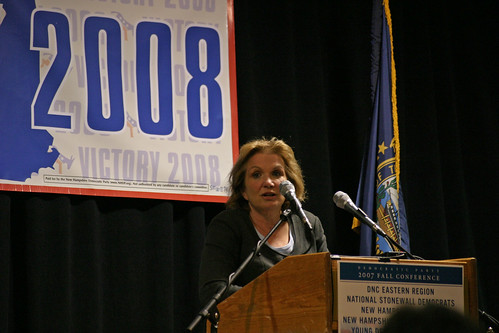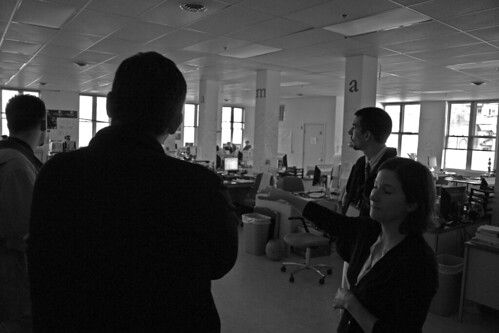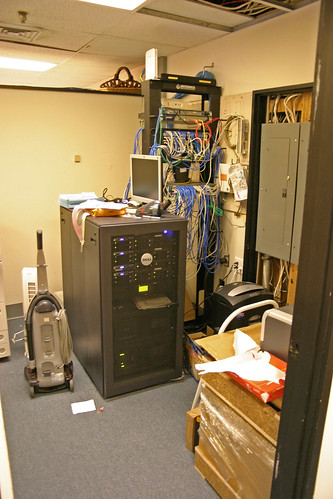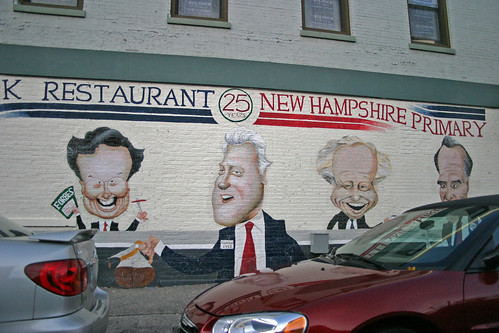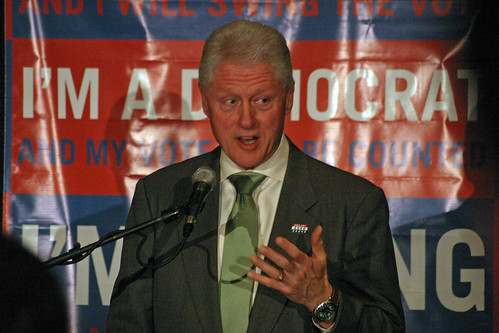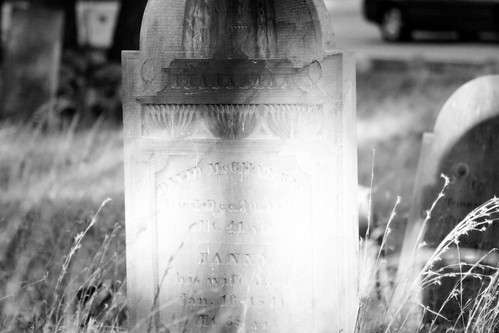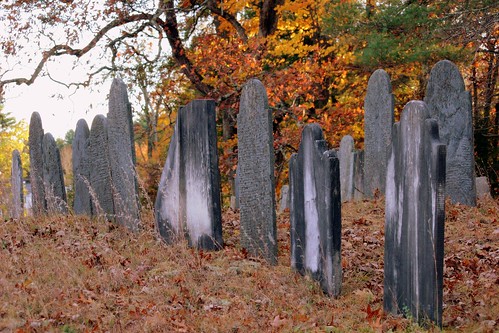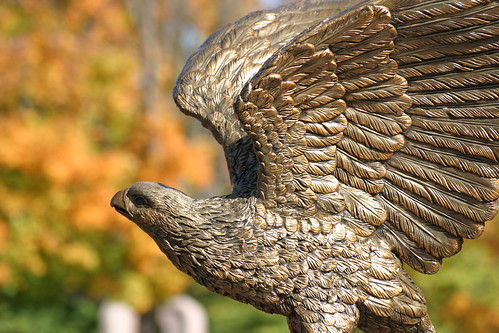This weekend was the Youth Democrats of America conference in Manchester, NH. I’d toyed for months with renting a fast telephoto for the event. In hindsight, I’m glad I didn’t—most of the speakers I wanted to capture weren’t even there.
Bill Clinton was the first speaker. He delivered an amazing speech, but also kicked off what would rapidly become an irritating trend—unabashed praise of Hillary. Right before Hillary was the state chair of something (Youth Democrats?), who explained that he was prohibited from endorsing a candidate. So his speech began, “Effective Monday, I resign from my post. I’m going to join the Hillary campaign.” It seemed pretty inappropriate.
Clinton, though, was a great speaker, and it’s understandable that he’d back Hillary. He talked about how excited the debates last week made him—the Democrats weren’t debating whether global warming was a myth, or whether health care was broken. They were debating the best way to fix it. I wish I had a better recall of the exact figures, but he mentioned that the US pays something like $700 billion a year more than any other nation on healthcare. He said that if we were to close our eyes, pick a country, and copy their health care system, we’d end up saving a lot of money. So he complained about the people that whine about “socialized medicine”—even if we went with a truly Socialist plan, it would save us money. But no one proposed that we become Socialists anyway.
The next morning we had a series of luncheon speakers. Most of them were pretty bad. The first one stood up there before it started pleading with us to hurry up. Like, probably every 90 seconds he’d make an announcement, alternating between asking us to get food and asking us to get food quickly and reminding us that there were two separate lines. And he’d add in “funny” comments like, “If the person in front of you is taking too long, shove them,” which really didn’t do anything but grate on our nerves. And then we had a series of speakers that no one knew that really weren’t that good. One of them I think was taking some serious drugs or something. He started of by talking about going “back to the future,” and all sorts of other things, and never really tied any of them together. And there was this joke that none of us even understood about Bush getting off an airplane carrying two pigs, but he started it off by pretending it was an actual news story. We were talking about it afterwards, and basically all admitted that we had either laughed because everyone else was and we didn’t want to seem like we got it, or, for a few people, they laughed just out of sympathy because he’d taken so long setting up for it and yet it came out making no sense.
They served this big elaborate lunch, but only had coffee and water. So a few of us go find a vending machine. And I guess Elizabeth Edwards was just standing outside waiting until she was called as the next speaker, so they were able to just go talk to her. “And she talked back!” they said with some surprise. They came back and told us, so a few more of us went to see her, but she was going in right as we were coming out. So instead we went to find the vending machine. After checking a bunch of likely places, I asked at the front desk. “They’re on every odd floor—so 3, 5, 7, 9, and 11,” she told me. (One might assume that the lobby is an odd floor, but it’s called “Lobby,” followed by “Mezzanine” above, and then 3. So we took the elevator up to the third floor, bought a can of Dr [sic] Pepper for $1, and went back, by which time Elizabeth Edwards was speaking.
She delivered a really good speech about Edwards. I was very impressed, and when she turned it over to questions, the first question summed it up well: “Why aren’t you running for office?” The question drew a lot of applause. She’d make an amazing First Lady, because she really knows her stuff! And then a woman asked, “My partner and I have been together for 30 years. When I say that we want to be married, how would your husband—and how would you—answer us?” (Edwards has stood out as the Democrat most opposed to same-sex marriage.)
Her answer again drew applause, when she started off with, “Well, those are two separate questions.” Her answer was actually even more impressive, as she began talking about how it’s an “evolving issue” and that she hopes John’s stance would change with time. (Now you see why people wanted her to run?)
Someone else asked for her opinion on some obscure personal attack on a politician. Her answer was basically that she thinks it’s very important that the American people grill candidates with questions, but that sometimes people don’t respect people’s personal lives. She gave the example of people obsessed with Romney’s Mormonism, and then, “And some people criticized John for continuing in spite of my illness… I think that’s inappropriate.” (Again, applause.)
The rest of that day was going to be some sort of canvassing event that none of us wanted to go to. So we instead took the time to tour the local campaign headquarters of the candidates. We were given some really vague directions, and people kept expecting me to know all the backroads around Manchester. One direction involved turning at a prison, which somehow got misinterpreted. We pulled into a prison parking lot, and everyone was walking in. I pointed this out, but they insisted that his headquarters were inside. “No, there is no way that Obama has set up his headquarters inside a prison,” I argued. Someone else suggested, “Well, as long as we’re here, let’s just go inside and check.” I finally persuaded them that it would be incredibly embarrassing to walk into a prison and ask if Obama’s headquarters were there. (Actually, it would probably get interpreted as some sort of racist joke, as opposed to sheer idiocy?)
So we continued down the road, and not a half mile later, we were at the Obama headquarters. It was actually in the middle of nowhere, but the place was huge:
That just shows a small part of the office. It was substantially larger. Hillary’s offices weren’t as nice inside, though they were in a very plush office complex. But she wins points for largest IT infrastructure:
N.B. that this server closet just powers this one little branch of Hillary’s <i>many</i> campaign offices.
At both places, the staff was more than happy to take a few minutes to show us around and talk about why they were supporting their candidate. I was really struck that all these volunteers seemed so professional.
And then we went to the Kucinich headquarters. I didn’t take any pictures inside, because it was a small place and would have been awkward. In hindsight, I really, really wish I had.
It was above this big restaurant, though, with an obvious political history. Inside we found a couple surprised volunteers. “We were in the middle of something,” one of them said, as the other jokingly added, “Inauguration planning.” “But we can talk to you for a couple minutes.” We thought it was pretty strange. One of them moved and a lighter fell out of his pocket. They both seemed pretty… mellow… as they talked to us, and were really all of the place in topics. They actually raised some good points, but the whole thing was really pretty creepy and left me liking Kucinich even less. (The quizzes I’ve taken say he’s my best match, but there’s more than just his stance on the issues that matters. If I were running for President, for example, and saw a UFO one night at home, I might think, “Gee, I’d probably look pretty crazy if I brought that up” and not mention it.) They ended up talking to us at length. At one point someone else came in, seemed surprised anyone was there, and went through these tiny little doors into some sort of oversized closet in the back room. It was amusingly creepy.
After we left, we started talking about how weird the whole thing had been. Someone asked, “Was I the only one that thought it smelled like weed?” Someone else agreed, and then we discussed them dropping a lighter, and how vague the “Oh, we were doing something, but I guess we can talk to you” thing was. And the sketchy back room.
This is not how you should be running a campaign? At all?
We ended up being pretty unimpressed with the YDA Conference, though. We had a good time and got lots done, but some of the best parts were when we skipped the official parts of it and did stuff on our own. We were initially told there’d be “Presidential speakers,” which we naively took to mean that the candidates would be there. Bill Clinton was the big one, followed by Elizabeth Edwards. Kucinich was supposed to be there but canceled. (Don’t worry, plenty of jokes about him, UFOs, and green leafy substances consumed in the back room of campaign offices have already been made to explain his absence.) Obama was never scheduled to come, it turns out, and his “speaker” was his half sister. We were going to go, but it was actually a “party” in the back room of some pub that was very overcrowded. So we left. We ended up not even sticking around today, after seeing the only interesting event of the day (Kucinich) had been canceled.

